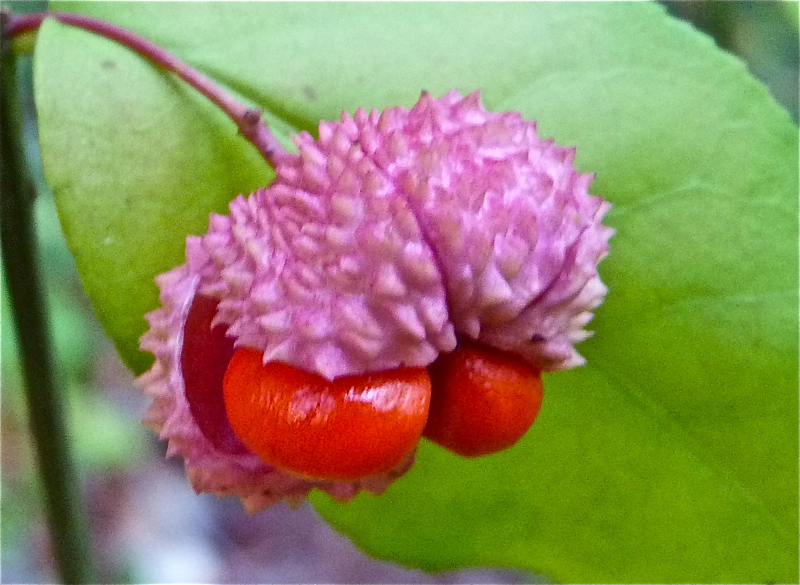Deep in deciduous woods from southern New York to Florida and as far west as Oklahoma and eastern Texas, there grows an unassuming native shrub with a certain pathos about its name. In Greek mythology Euonyme was the mother of the deities who caused suffering in everyday life, and Euonymus americanus grows most prolifically in Appalachian regions where tough topography and poverty traditionally make life difficult.
The shrub is also commonly called strawberry bush and hearts-a-bustin. It's easy to see why.In early fall the seed pods turn from green to pink. Resembling wild strawberries, they are warty looking and about the size of acorns. As they open to reveal scarlet seedheads, the capsules split into heart shaped segments. The fruit are decorative, and I first fell in love with this plant when I came across a specimen covered with the interesting capsules.
Early this year, I made the difficult decision to remove the agressive nandina domestica from my woodland garden, and I planted a variety of shrubs in its place. This was a great opportunity to try Hearts-a-bustin in my own garden. I like it because it is native to my region and because it is not aggressive, unlike its non-native cousin Euonymus alata, also called burning bush, which in some areas is very aggressive. Hearts-a-bustin will put out suckers and can form thickets, but it will not spread wildly through the forest or displace other plants.
Euonymus americanus has thin green stems and an open, airy habit to about six feet tall. The deciduous shrub produces two to three inch lance shaped green leaves.  Tiny yellow-green, star shaped flowers appear in the spring. They are beautiful, but you have to look at the flowers closely to appreciate them. Bees love the flowers, and deer will browse upon the leaves. I am fortunate that my woodland garden is in the middle of a small city, so I don't have to worry about the deer! Some birds will eat the seeds, but they can be poisonous to humans if eaten in large quantities, and they are also said to be poisonous to sheep.
Tiny yellow-green, star shaped flowers appear in the spring. They are beautiful, but you have to look at the flowers closely to appreciate them. Bees love the flowers, and deer will browse upon the leaves. I am fortunate that my woodland garden is in the middle of a small city, so I don't have to worry about the deer! Some birds will eat the seeds, but they can be poisonous to humans if eaten in large quantities, and they are also said to be poisonous to sheep.
In September through October the understated shrub assumes the spotlight as its seed capsules dangle like bright ornaments. The leaves also are beautiful as fall advances, becoming translucent white, washed with shades of red and orange.
The leaves also are beautiful as fall advances, becoming translucent white, washed with shades of red and orange.
This shrub should be planted beside a path so one can easily appreciate its charms. It is a terrific low maintenance shrub - pest free and drought tolerant! It is comfortable in the woodland setting and grows best in sun dappled shade in humus rich, slightly acid soil.